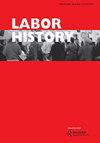解放是一种幻觉:对苏联和中国工厂管理政策的回顾
IF 0.7
4区 管理学
Q1 HISTORY
引用次数: 0
摘要
摘要19世纪工业资本主义的出现无疑改变了工厂的生产过程,人类历史上第一次出现了大规模生产的理论和实践。泰勒和福特等先驱者在工业资本主义下进行了革命性的工厂生产和管理创新。然而,工人的基本权利以及大型工厂的基本权利在很大程度上被忽视了。马克思、恩格斯、列宁、葛兰西开始以工业资本主义的大生产为基础,形成工人解放的理论和实践。苏联和中国作为世界上最重要的两个社会主义国家,在马克思主义理想的基础上,实行了工厂一级的解放政策。本文通过一个三角比较模型来考察苏联和中国是否实现了工人解放的理想。本文提出了一个工人解放的理论,主要基于马克思主义的理想,并横向比较了苏联和中国的实践。最后,文章得出结论:苏中两国的工人解放理想虽然都对工人解放有一定贡献,但都没有完全实现;实现解放理想的失败使得两国对解放的要求仅仅是“幻想”。关键词:马克思主义;劳动历史;工人解放;工厂管理;苏联;中国;复旦大学陈周旺教授、尹志光教授、孙志强教授、权石教授、李玉华教授、葛泽坤教授、于大浩教授;芒仁墨香委员会的同事们,《劳动史》和《泰勒与弗朗西斯》的编辑们,尤其是我深爱的女友墨旭,感谢他们在本文的起草、写作和编辑过程中给予我的无私帮助。披露声明作者未报告潜在的利益冲突。这就是所谓的“价格工资”体系。在这种制度下,生产更多产品的工人将获得更多的工资作为奖励。本系统将在本文后面介绍。作者报告没有需要申报的资金。作者简介:本文作者是上海复旦大学国际关系与公共事务学院政治学系博士研究生。主要研究领域为社会主义国家劳工史、中国政治、现代政治思想和马克思主义。作者于2020年夏季在多伦多大学以优异成绩获得学士学位。作者于2021年冬季在伦敦大学学院获得第一个硕士学位(文学硕士),并于2022年冬季在伦敦政治经济学院获得第二个硕士学位(理学硕士)。本文章由计算机程序翻译,如有差异,请以英文原文为准。
Emancipation as an illusion: a review of factory management policies in the Soviet Union and China
ABSTRACTThe emergence of industrial capitalism in the 19th century undoubtedly changed production processes in factories, and mass production theories and practices emerged for the first time in human history. Pioneers, namely Taylor and Ford, had revolutionary factory production and management innovations under industrial capitalism. However, the basic rights of workers, along with those of large factories, have been largely neglected. Marx, Engels, Lenin, and Gramsci began to formulate theories and practices of workers’ emancipation based on the mass production of industrial capitalism. As the two most important socialist countries on Earth, the Soviet Union and China have practiced emancipatory policies at the factory level based on the Marxist ideal. Through a triangular comparison model, this article examines whether the Soviet Union and China have achieved their ideals of worker emancipation. This article proposes a theory of workers’ emancipation, mainly based on the Marxist ideal, while Soviet and Chinese practices are compared horizontally. In the end, the article concludes that both the ideals of the Soviets and Chinese on workers’ emancipation have not been fully achieved despite both having some contributions to worker emancipation; the failure of achieving the emancipatory ideal rendered both countries’ claims on emancipation as mere ‘illusions.’KEYWORDS: Marxismlabor historyworkers emancipationfactory managementthe Soviet UnionChina AcknowledgmentsThe author would like to express special thanks of gratitude to the following scholars and organizations: Prof. Chun Lin, Dr. Hans Steinmuller, Dr. William Matthews, Dr. Andrea Pia at London School of Economics; Prof. Zhouwang Chen, Prof. Zhiguang Yin, Zhiqiang Sun, Shi Quan, Yuhua Li, Zekun Ge, and Dahao Yu at Fudan University; Colleagues of Mang Ren Mo Xiang Committee, editors of Labor History and Taylor & Francis, and above all my beloved girlfriend Mo Xu for their selfless help during drafting, writing and editing of this paper.Disclosure statementNo potential conflict of interest was reported by the author(s).Notes1. This is known as the ‘price-wage’ system. Under such system, workers who produce more products would get more wages as rewards. This system will be introduced later in the text.Additional informationFundingThe author reports there is no funding to declare.Notes on contributorsRuiyang HuHu, Ruiyang (the author) is a PhD Candidate at the Department of Political Science, School of International Relations and Public Affairs, Fudan University in Shanghai, People’s Republic of China. His research focuses on labour history of socialist nations, Chinese politics, modern political thought, and Marxism. The author obtained his bachelor’s degree with distinction at University of Toronto in summer 2020. The author obtained his first master degree (Master of Arts) with merit at University College London in winter 2021, and his second master degree (Master of Science) with merit at London School of Economics and Political Science in winter 2022.
求助全文
通过发布文献求助,成功后即可免费获取论文全文。
去求助
来源期刊

Labor History
Multiple-
CiteScore
1.00
自引率
28.60%
发文量
44
期刊介绍:
Labor History is the pre-eminent journal for historical scholarship on labor. It is thoroughly ecumenical in its approach and showcases the work of labor historians, industrial relations scholars, labor economists, political scientists, sociologists, social movement theorists, business scholars and all others who write about labor issues. Labor History is also committed to geographical and chronological breadth. It publishes work on labor in the US and all other areas of the world. It is concerned with questions of labor in every time period, from the eighteenth century to contemporary events. Labor History provides a forum for all labor scholars, thus helping to bind together a large but fragmented area of study. By embracing all disciplines, time frames and locales, Labor History is the flagship journal of the entire field. All research articles published in the journal have undergone rigorous peer review, based on initial editor screening and refereeing by at least two anonymous referees.
 求助内容:
求助内容: 应助结果提醒方式:
应助结果提醒方式:


